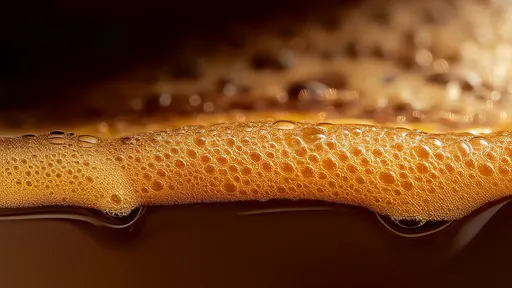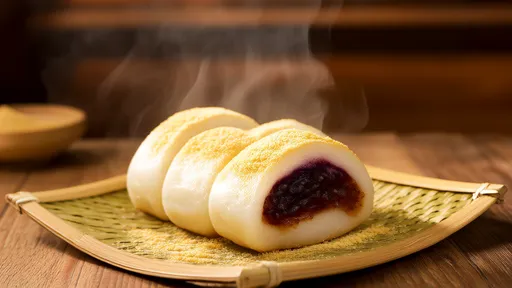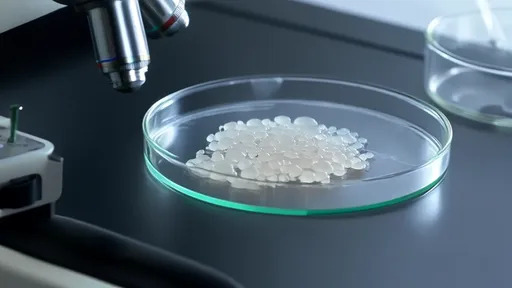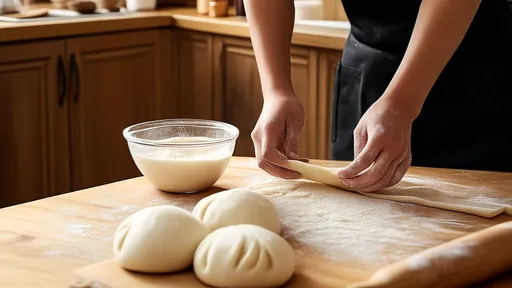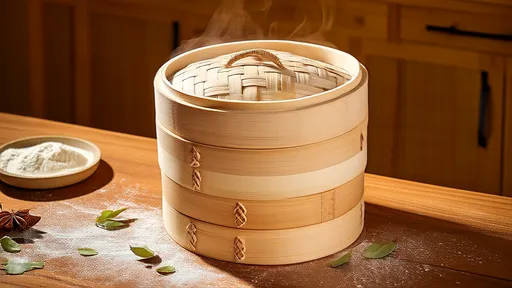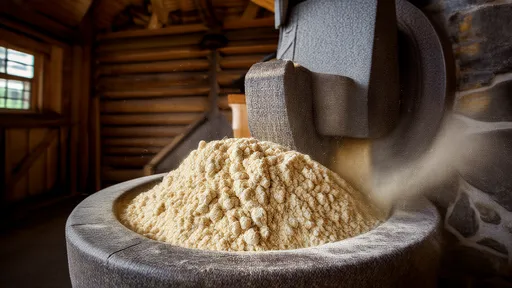The art of baking a perfect cake relies heavily on understanding the science behind its structure. Among the many factors that contribute to a cake's texture, the uniformity of air pockets within the cake crumb stands out as a critical element. This characteristic is largely influenced by the foaming properties of proteins in the batter, particularly those found in eggs. The way proteins trap and stabilize air bubbles during mixing directly impacts the final product's lightness, tenderness, and overall mouthfeel.
When egg whites or whole eggs are whipped, their proteins unfold and form a network around air bubbles. This process, known as protein denaturation, creates a stable foam that serves as the foundation for the cake's rise. The quality of this foam determines how evenly the air pockets distribute throughout the batter during baking. A well-formed protein network will yield countless tiny bubbles that expand uniformly when heated, resulting in a fine, even crumb structure.
The temperature at which eggs are whipped plays a significant role in foam stability. Cold egg whites tend to produce more stable foams with smaller, more uniform bubbles compared to those whipped at room temperature. This is because colder temperatures slow down the movement of protein molecules, allowing them to form tighter networks around air pockets. Bakers often chill their mixing bowls and utensils before whipping egg whites to maximize this effect and achieve optimal bubble distribution.
Fat content presents another crucial factor in protein foaming and subsequent air pocket formation. While egg whites can create excellent foams on their own, the presence of even small amounts of fat (such as yolk residue or butter) can interfere with protein unfolding and bubble stabilization. This explains why recipes calling for whipped egg whites often emphasize the importance of clean, grease-free equipment. In whole egg foams, the natural emulsifiers in yolks help mitigate this effect to some degree, allowing for reasonably stable foams despite the fat content.
The mixing method employed significantly affects bubble distribution in cake batters. Techniques like the genoise method, where whole eggs and sugar are whipped together, create a foam that incorporates air throughout the liquid phase. This differs from methods that fold whipped egg whites into other batter components. Each approach produces distinct bubble structures that manifest differently in the baked cake's crumb. The key lies in maintaining bubble integrity during the folding process to prevent large air pockets from forming or small bubbles from collapsing.
As the cake bakes, several transformations occur simultaneously to set the bubble structure. The heat causes proteins to coagulate, permanently fixing the air cell walls in place. Simultaneously, water vapor and expanding gases fill these pockets, causing them to enlarge until the structure sets. If the protein network is too weak, bubbles may coalesce into irregular, oversized pockets. Conversely, an overly strong network might prevent proper expansion, resulting in a dense texture. Achieving the perfect balance requires precise control of mixing times, ingredient ratios, and baking temperatures.
Modern baking science has revealed that different proteins contribute uniquely to foam formation and stability. Ovalbumin, the main protein in egg whites, provides structural strength when heated. Meanwhile, globulins help initiate foam formation during whipping, and ovomucin contributes to long-term foam stability. Understanding these protein interactions allows bakers to manipulate batter characteristics for specific textural outcomes. Professional bakers often adjust egg handling techniques based on these protein properties to achieve desired crumb structures.
The pH level of the egg foam also influences bubble uniformity. Slightly acidic conditions, often achieved by adding cream of tartar or vinegar, help stabilize egg white foams by modifying protein interactions. This stabilization prevents bubbles from coalescing too quickly, leading to a more uniform distribution of smaller air cells. The effect is particularly noticeable in angel food cakes, where the acidic environment contributes to the characteristic fine, cloud-like texture.
Ingredient quality dramatically affects the foaming process and final cake structure. Fresh eggs typically produce more stable foams than older ones because their protein structures are more intact. Similarly, the type of sugar used can impact bubble stability; finer sugars dissolve more readily in the egg foam, creating a more uniform syrup that better supports the protein network. These subtle differences underscore why professional bakers pay meticulous attention to ingredient selection and handling.
Moisture content in the batter plays a dual role in air pocket formation. While sufficient liquid is necessary for protein mobility and foam formation, excess water can weaken the protein network, leading to bubble collapse. The ideal balance ensures that bubbles expand properly during baking without losing their structural integrity. This explains why precise measurement of liquid ingredients is crucial for consistent results in cake baking.
Alternative protein sources present both challenges and opportunities for achieving uniform crumb structures. Plant-based proteins from sources like aquafaba (chickpea brine) or flaxseed can create reasonable foams, but their different molecular structures often require modified techniques to approximate the bubble uniformity of egg-based foams. Food scientists continue to explore these alternatives, seeking ways to replicate the textural qualities of traditional cakes while meeting diverse dietary needs.
The baking process itself serves as the final determinant of air pocket uniformity. Oven spring—the rapid expansion of gases during the initial baking phase—must occur evenly throughout the cake for consistent texture. Uneven heating can cause some areas to set too quickly while others continue expanding, resulting in irregular pore sizes. Proper oven calibration and baking vessel selection help mitigate these issues, ensuring heat transfers uniformly to all parts of the batter.
Advanced imaging techniques have allowed researchers to study cake crumb structures with unprecedented detail. Microscopic analysis reveals how subtle changes in mixing technique or ingredient proportions affect the three-dimensional arrangement of air pockets. This scientific approach has led to refined methods for achieving specific textural profiles, from the tight, even crumb of pound cakes to the more open structure of sponge cakes.
Commercial bakeries face additional challenges in maintaining bubble uniformity at scale. Large batch mixing introduces variables not present in small-scale baking, such as prolonged exposure to friction heat or uneven incorporation of ingredients. Industrial solutions often involve specialized mixing equipment that gently folds ingredients while minimizing bubble disruption, along with precise temperature control systems to maintain ideal foaming conditions throughout production.
Consumer expectations continue to drive innovation in cake texture optimization. The growing demand for gluten-free options, for instance, has prompted extensive research into alternative systems for bubble stabilization. Without gluten's elastic network, these formulations rely more heavily on protein foams to create structure, making the understanding and control of air pocket uniformity even more critical to product success.
Looking forward, the intersection of culinary tradition and food science promises continued refinement in cake texture engineering. As researchers uncover more about protein behavior at the molecular level, bakers gain increasingly precise tools for manipulating crumb structure. This knowledge not only improves traditional cake quality but also opens doors to entirely new textural experiences in baked goods.
The art of baking a perfect cake relies heavily on understanding the science behind its structure. Among the many factors that contribute to a cake's texture, the uniformity of air pockets within the cake crumb stands out as a critical element. This characteristic is largely influenced by the foaming properties of proteins in the batter, particularly those found in eggs. The way proteins trap and stabilize air bubbles during mixing directly impacts the final product's lightness, tenderness, and overall mouthfeel.
The world of sensory evaluation is as intricate as it is fascinating, particularly when it comes to understanding how we perceive flavors and aromas. Among the myriad of compounds that contribute to our sensory experiences, vanillin—the primary component of vanilla extract—stands out for its widespread use and complex interaction with our senses. The concept of odor threshold plays a pivotal role in determining how much of this compound is needed for it to be detectable, and it varies significantly depending on the medium in which it is presented.
The world of chili peppers is as diverse as it is fiery, with each variety packing its own unique punch. At the heart of understanding this heat lies the Scoville Scale, a measurement that quantifies the spiciness of peppers. Developed by Wilbur Scoville in 1912, this scale remains the gold standard for gauging the capsaicin content—the compound responsible for that burning sensation—in different peppers. From the mild bell pepper to the mind-numbing Carolina Reaper, the Scoville Scale offers a fascinating glimpse into the spectrum of heat that chili enthusiasts chase.
The culinary world has long celebrated the magic that happens when certain ingredients come together, creating flavors greater than the sum of their parts. One such pairing—chicken broth and mushrooms—exemplifies the scientific and gastronomic phenomenon known as umami synergy. This dynamic duo has been a staple in kitchens across cultures, from French consommé to Japanese ramen, and its power lies in the way their compounds interact to amplify savory depth.
The world of fermented foods is a fascinating intersection of microbiology, chemistry, and culinary tradition. Among these, kimchi stands out not only for its bold flavors but also for the intricate biochemical processes that transform raw vegetables into a probiotic-rich delicacy. At the heart of this transformation lies a phenomenon known as acetic acid penetration, which creates a dynamic pH gradient during fermentation. This process is far more than a simple souring of cabbage—it's a carefully orchestrated dance between microbial communities and their chemical environment.
The turbidity of fruit juice, often perceived as a mark of freshness and natural quality, is primarily governed by the suspension mechanisms of pulp particles. These tiny fragments of fruit flesh, ranging from cellular debris to larger fibrous clusters, create the characteristic cloudiness that consumers associate with premium products. Behind this seemingly simple phenomenon lies a complex interplay of physical forces, biochemical interactions, and processing variables that determine whether pulp remains evenly dispersed or separates over time.
The fizz in your soda isn't just about taste—it's a carefully engineered dance between gas and liquid that begins unraveling the moment you twist open the cap. Few consumers realize how precisely carbonation levels are calibrated, or how dramatically pressure dynamics shift during that first explosive release. This invisible physics experiment in every bottle follows predictable but fascinating patterns that beverage scientists have spent decades mapping.
The world of espresso is as complex as it is captivating, with its rich flavors and aromatic allure. At the heart of this complexity lies a seemingly simple yet scientifically intricate component: the crema. This golden-brown layer of foam that crowns a well-pulled shot of espresso is not just a visual delight but a fascinating study in colloidal stability. The interplay of oils, gases, and solids in espresso crema reveals a delicate balance that defines the quality and texture of the coffee.
The phenomenon of "cold turbidity" or "cream down" in tea has long intrigued both tea connoisseurs and scientists alike. This natural occurrence, where tea liquor turns cloudy upon cooling, is not merely an aesthetic curiosity but a window into the complex chemistry of tea. Recent advancements in optical measurement techniques have enabled researchers to quantify this phenomenon through turbidity detection based on tea liquor transmittance, opening new avenues for quality assessment and understanding of tea's molecular interactions.
The world of instant noodles thrives on convenience, but behind that simplicity lies a carefully engineered marvel of food science. At the heart of this innovation sits pregelatinized starch—an unsung hero that transforms dehydrated noodles into a steaming bowl of comfort within minutes. Unlike traditional starch, pregelatinized starch undergoes a thermal and mechanical treatment that breaks down its granular structure, allowing it to absorb water rapidly. This property is pivotal for instant noodles, where rehydration speed and texture determine consumer satisfaction.
The world of traditional fermented foods holds countless microbial secrets, and few are as fascinating as the complex ecosystem of laomian – the centuries-old sourdough starter that gives Chinese steamed bread its distinctive character. While modern bakeries increasingly rely on commercial yeast, artisanal producers across northern China still maintain their family laomian cultures like precious heirlooms, passing down not just techniques but living microbial communities through generations.
The sticky, chewy texture of glutinous rice cakes, known as mochi in Japanese or nuòmǐ cí in Chinese, has long been a staple in East Asian cuisine. These delectable treats, often enjoyed during festivals or as everyday snacks, owe their unique consistency to a key component: amylopectin, the branched-chain starch found in glutinous rice. However, anyone who has left mochi or Chinese mochi cakes (糍粑) at room temperature for a few hours will notice an unmistakable transformation—the once-soft and pliable dessert gradually hardens, becoming tougher and less enjoyable. This phenomenon, often referred to as retrogradation, is a fascinating interplay of chemistry, physics, and culinary science.
The art of cooking perfect rice lies in understanding the gelatinization temperature of different japonica rice varieties. This scientific parameter, often overlooked by home cooks, determines the precise moment when starch granules absorb water and swell—fundamentally shaping texture, flavor release, and nutritional accessibility. Recent studies across Asian research institutions reveal how subtle genetic variations in short-grain rice cultivars create distinct thermal behaviors during cooking, challenging the one-size-fits-all approach to water ratios and heat application.
The art of crafting perfect hand-pulled noodles lies in mastering the delicate balance between gluten development and dough relaxation. Among the many variables that influence noodle extensibility, resting time stands as one of the most critical yet often overlooked factors. This silent alchemy occurring during the waiting period transforms a stiff, unyielding mass into an elastic, cooperative material ready to be stretched into silky strands.
For generations, home cooks and professional chefs alike have relied on stainless steel containers for pickling and food storage. The material's reputation for durability and corrosion resistance makes it a seemingly ideal choice. But when acidic ingredients like vinegar enter the equation, questions arise about potential metal leaching and food safety. Understanding the interaction between stainless steel and pickling brines requires a deeper dive into metallurgy, chemistry, and culinary science.
The bamboo steamer, a centuries-old culinary tool cherished across Asian kitchens, operates on principles far more sophisticated than its simple appearance suggests. Among its most fascinating phenomena is the so-called "bamboo steamer effect" – a self-regulating mechanism that prevents the dreaded condensation drip-back, ensuring perfectly textured dumplings, buns, and fish every time. This natural engineering marvel has captivated chefs and scientists alike, revealing how traditional wisdom often anticipates modern food science.
The age-old practice of stone milling has long been revered for its ability to produce flour that retains the natural goodness of whole grains. Unlike modern industrial milling methods, which often prioritize speed and shelf life, stone grinding operates at a slower pace, preserving the integrity of the grain’s nutritional profile. One of the most significant advantages of this traditional method is its ability to maintain higher levels of dietary fiber in whole wheat flour—a component essential for digestive health, blood sugar regulation, and overall well-being.







